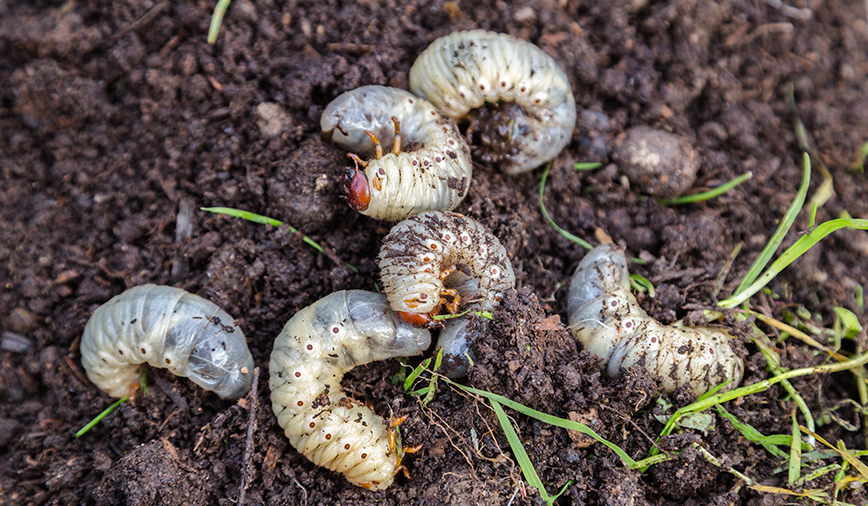April 25, 2014
Grubs
The English language contains some pretty lovely sounding words:
Ebullience.
Effervescent.
Epiphany.
Each term features a delectable combination of vowels and consonants that virtually sparkle as they roll off the tongue, bringing with them emotions and images that are bright and uplifting.
Then we have the opposite end of the spectrum. Heavy and dull, these words are the verbal equivalent of road apples landing on pavement:
Phlegm.
Dung.
And the topic of this week’s commentary: Grub.
Actually, make that grubs, plural. A whole heaping, writhing mess of ’em.
I wish you could have heard the tone of Joan Kramer’s voice when she called to tell me of her squirmy, wriggly find. Amid clucks of disgust, with a slight undercurrent of fear, she asked, “There isn’t any reason, is there, that you’d want grubs?
Now, let us not forget, Joan is no nature newbie. Over her years of tending the Native Plant Demonstration Garden at the Pottawatomie Community Center, she has seen literally hundreds of species of plants and animals in all stages of life. And with the exception of a few types of invasive non-natives (and snakes, but that’s another story) she has been quite tolerant of them all.
But grubs, for Joan, crossed a line. Because, let’s face it, their reputation is less than stellar. What instar, or insect life stage, gets blamed for destroying lawns? Grubs. Which insect life form is reviled by farmers and gardeners everywhere? Grubs.
Plus, they have that awful, clunky-sounding name.
So there was poor Joan, alone in the garden, facing a mound of hardwood mulch from which she’d unearthed not just one or two, but rather dozens of grubs. The very animal for which the insecticide GrubEx was created.
If she spread the infested mulch throughout the garden, would she risk the demise of the all the plants there? The plants she has coaxed and tended year after year? The plants that serve as a learning resource native landscaping enthusiasts throughout the region?
The simple answer is: No.
And my equally easy answer to Joan’s question of whether I’d have use for the grubs is: Yes. Yes! A thousand times yes!
Because grubs, as horrid of a reputation as they may have, are not created equal. Sure there are those that devour plant roots. (In the bigger scheme of ecosystem health, this is an important niche, even though it makes them unpopular with farmers and gardeners.)
But then there are those grubs that you can think of as “the good guys.” Like the hero that rides into town wearing a white hat, these pale-colored, soft-bodied larvae of various beetle species have an important job to do: They help dead wood decompose. Gifted with chewing mouthparts and a wonderfully complex digestive system, these little jewels turn tough, woody tissue back into soil so it can once again grow the plants that we love.
The fact that Joan found “her” grubs in hardwood mulch, rather than inside a planter coiled amongst roots, made their designation as “good” grubs a fairly logical assumption. The hard part was going to be trying to identify their family and or genus.
North America is home to more than 10,000 different species of beetles. Even after eliminating all those whose larvae look like mealworms, caterpillars or extraterrestrials, there are still an awful lot that are seemingly just plain white and grubby.
Coleopterists sometimes devote their entire lives to exploring just one small area of this very large insect order. How could I, a mere naturalist, figure out what kind of grubs were bugging Joan?
I started by thinking of the kinds of decomposer beetles that are most common around here, namely the stag beetles, a.k.a. the Lucanidae, or pinching bugs. But a quick peak at the grubs’ hindquarters ruled out that genus. Stag beetles have what is known as a longitudinal anal opening. Joan’s grubs, it was quite clear, had openings that were transverse.
Long story short, I’m still not 100% sure just what sort of “good guys” we’re dealing with, but I have a couple of strong hunches. Various references as well as my favorite on-line resource, BugGuide.net, have led me to a genera known as Osmoderma—a name that translates roughly as smelly skin.
These insects, which in their adult form reportedly smell like leather, inhabit the decaying centers of various hardwoods. They have multi-year life cycles that culminate in the formation of an earthen-walled pupal chamber and the emergence of a medium-sized, dark-colored beetle an inch or so in length.
Another cool thing about Osmoderma: their frass, or droppings, are appealingly described as “Chiclet shaped.” I love Chiclets!
My plan from here on out is fairly straightforward: 1. Keep Joan’s darlings a) away from Joan and b) happy and healthy in a large terra cotta pot filled with mulch and oak leaves. 2. Periodically take a stab at identifying them, keeping an eye out for “chiclets.” 3. Use them as needed for education and outreach, including our upcoming Bug Biographies programs for second graders. 4. Repeat for up to three years, until all grubs have pupated and emerged as adults.
Maybe along the way I’ll have an epiphany and identify the little guys not just to genus but species. If that should happen, I can guarantee, I’ll be not just effervescent, but positively ebullient.
Pam Otto is the manager of nature programs and interpretive services at the Hickory Knolls Discovery Center, a facility of the St. Charles Park District. She can be reached at 630-513-4346 or potto@stcparks.org.

